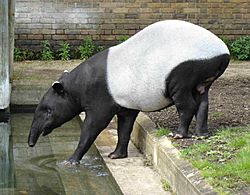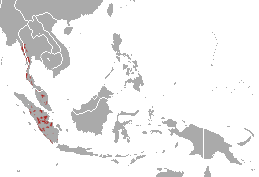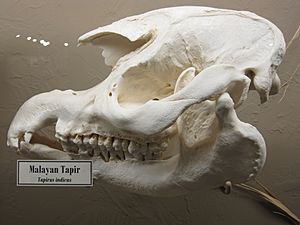Malayan Tapir facts for kids
Quick facts for kids Malayan Tapir |
|
|---|---|
 |
|
| Malayan Tapir (London Zoo) | |
| Conservation status | |
| Scientific classification | |
| Kingdom: | |
| Phylum: | |
| Class: | |
| Order: | |
| Family: | |
| Genus: | |
| Species: |
T. indicus
|
| Binomial name | |
| Tapirus indicus (Desmarest, 1819)
|
|
 |
|
| Malayan Tapir range | |
The Malayan Tapir (Tapirus indicus) is also known as the Asian Tapir. It is the biggest of the five types of tapirs. It's also the only tapir that naturally lives in Asia. Its scientific name points to the East Indies, where it comes from. In the Malay language, people often call this tapir "cipan", "tenuk", or "badak tampong".
Contents
Appearance and Features
This animal is easy to spot because of its unique markings. It has a light-colored patch that goes from its shoulders to its back end. The rest of its fur is black. Its ear tips are white, just like other tapirs.

This pattern helps the tapir camouflage itself. The broken colors make it harder for other animals to see it clearly. When it lies down to sleep, it might even look like a big rock instead of prey.
Malayan tapirs grow to be about 1.8 to 2.5 meters (6 to 8 feet) long. Their short tail is only 5 to 10 centimeters (2 to 4 inches) long. They stand 90 to 110 centimeters (3 to 3.6 feet) tall. They usually weigh between 250 and 320 kilograms (550 to 705 pounds). Some adults can weigh up to 540 kilograms (1,190 pounds). Female tapirs are usually larger than males.
Like other tapirs, they have short, stubby tails. They also have long, flexible noses called proboscises. They have four toes on each front foot. On each back foot, they have three toes. Malayan tapirs don't see very well. However, they have excellent hearing and a great sense of smell.
They have a large bone on top of their skull called a sagittal crest. This bone is important for strong muscles to attach to. Their eye sockets are in unusual places. Their skull also has a unique shape, with the front bones raised. These special skull features make room for their long proboscis. Over time, as tapirs evolved, their proboscis caused changes in their face bones and cartilage.
How Malayan Tapirs See
Malayan tapirs have very poor eyesight. Because of this, they rely a lot on their excellent sense of smell and hearing. These senses help them with their daily activities. They have small, dark eyes with brown centers on the sides of their faces.
Their eyes often look like they have a blue haze. This is called corneal cloudiness. It happens when the cornea (the clear front part of the eye) starts to lose its clearness. The cornea helps light enter and focus in the eye. Cloudiness can make vision blurry or cause vision loss. This means Malayan tapirs have very bad vision. This is true both on land and in water, where they spend a lot of their time. Since they are most active at night, their poor eyesight makes it harder to find food and avoid predators in the dark.
All-Black Tapirs
A few all-black Malayan tapirs have been seen. This is called melanism. In 1924, an all-black tapir was sent to Rotterdam Zoo. It was named Tapirus indicus brevetianus after its discoverer, Captain K. Brevet.
In 2000, two all-black tapirs were seen in Malaysia. This happened during a study of tigers. The reason for this all-black color might be a genetic change. It's similar to how black panthers appear in groups of spotted jaguars. Scientists need to study more of these all-black tapirs. Until then, the exact reason for this trait is not fully known.
Life Cycle
A female Malayan tapir is pregnant for about 390 to 395 days. After this, she gives birth to one baby. The baby weighs around 6.8 kilograms (15 pounds). Malayan tapirs are the biggest tapir species when they are born. They also grow faster than other tapirs.
Young tapirs of all kinds have brown fur with white stripes and spots. This pattern helps them hide well in the dappled light of the forest. This baby coat changes to adult colors when they are between four and seven months old. Babies stop drinking milk between six and eight months of age. By then, they are almost fully grown. They can start having their own babies around age three.
Breeding usually happens in April, May, or June. Females typically have one baby every two years. Malayan tapirs can live up to 30 years. This is true whether they live in the wild or in zoos.
Behaviour
Malayan tapirs mostly live alone. They mark out large areas of land as their territory. These areas often overlap with other tapirs' territories. Tapirs mark their areas by spraying urine on plants. They often follow clear paths they have made through the thick plants.
These animals are herbivores, meaning they only eat plants. They look for soft shoots and leaves from over 115 types of plants. About 30 types are their favorites. They move slowly through the forest. They often stop to eat and smell for other tapirs.
If a tapir feels threatened or scared, it can run very fast. This is true even though they are quite large. They can also defend themselves with their strong jaws and sharp teeth. Malayan tapirs talk to each other with high-pitched squeaks and whistles. They usually like to live near water. They often bathe and swim. They can also climb steep hills. Tapirs are mainly active at night. However, they are not completely nocturnal. They tend to eat right after sunset or before sunrise. They often nap in the middle of the night. This behavior means they are crepuscular animals.
Habitat and Threats
The Malayan tapir used to live in the tropical lowland rainforests of Southeast Asia. This included countries like Cambodia, Indonesia, Laos, Malaysia, Myanmar, Thailand, and Vietnam. However, their numbers have gone down in recent years. Today, like all tapirs, they are in danger of extinction.
Because of their large size, tapirs have few natural enemies. There are not many reports of tigers killing them. The biggest threat to Malayan tapirs comes from human activities. This includes cutting down forests for farms (deforestation). It also includes floods caused by building dams on rivers for electricity. Another big problem is illegal trade. For example, in Thailand, a young tapir can be sold for about US$5,500.
In some areas, like Sumatra, most people are Muslim. Tapirs are rarely hunted for food there. This is because they look a bit like pigs, and eating pig meat is not allowed in Islam. But in some places, they are hunted for sport. Sometimes, they are shot by accident when people mistake them for other animals. Malaysia, Indonesia, and Thailand have laws to protect tapirs. These laws try to stop people from killing tapirs on purpose. However, they don't fully deal with the problem of habitat loss. This means the laws have not been very successful in helping the tapir population grow or stay stable.
See also
 In Spanish: Tapir malayo para niños
In Spanish: Tapir malayo para niños







